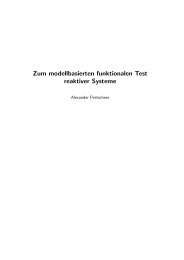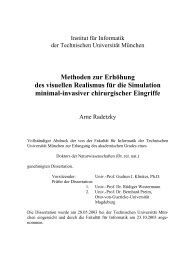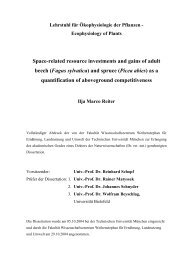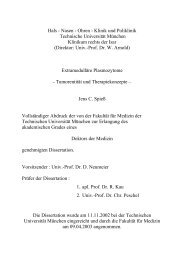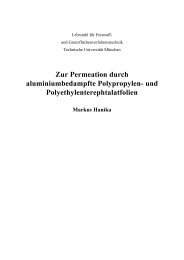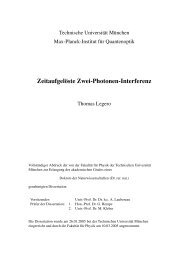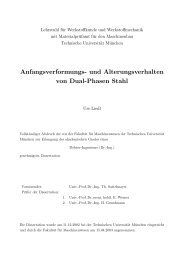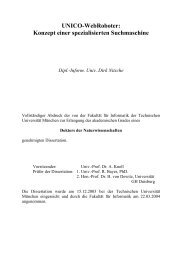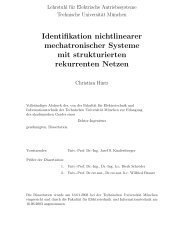Topologically Defined Neuronal Networks Controlled by Silicon Chips
Topologically Defined Neuronal Networks Controlled by Silicon Chips
Topologically Defined Neuronal Networks Controlled by Silicon Chips
You also want an ePaper? Increase the reach of your titles
YUMPU automatically turns print PDFs into web optimized ePapers that Google loves.
CHAPTER 2. NETWORKS OF DEFINED TOPOGRAPHY<br />
into A.<br />
Iinj,A = GA(VA,∞ − V0A) + GAB(VA,∞ − VB,∞) + GAC(VA,∞ − VC,∞) (2.32)<br />
GB(VB,∞ − V0B) = GAB(VA,∞ − VB,∞) + GBC(VC,∞ − VB,∞) (2.33)<br />
GC(VC,∞ − V0C) = GAC(VA,∞ − VC,∞) + GBC(VB,∞ − VC,∞) (2.34)<br />
GAB is the conductivity of the synapse between A and B. Index i denotes which neuron the current<br />
Iinj,i is injected into. The equations characterizing the situation before the current step are almost identical,<br />
but this time Iinj,i = 0 and index k in Vj,k is set to 0 instead of ∞.<br />
To determine the synaptic conductivities GAB, GAC and GBC, additional data are necessary from current<br />
step measurements with B and C being presynaptic. Providing another 12 equations, the resulting<br />
equation system yields rather lengthy solutions.<br />
Equations 2.32 - 2.34 can be brought into the same form as 2.21 and 2.23 <strong>by</strong> eliminating VC from 2.32<br />
and 2.33 with 2.34 and some rearrangements. This means that the three-neuron network again behaves<br />
like an isolated cell pair if probed with just two electrodes, one in A the other in B. Of course, the<br />
values for the somatic conductance and resting potentials differ from GA, V0A etc. as these ‘equivalent’<br />
quantities are governed <strong>by</strong> the network properties rather than the individual cells. Calculating the<br />
conductance between neuron A and B in analogy to an isolated pair results in a quantity G approx<br />
AB that is<br />
related to GAB <strong>by</strong>:<br />
G approx<br />
AB<br />
= GAB +<br />
GACGBC<br />
GAC + GBC + GC<br />
(2.35)<br />
For typical values of the somatic and synaptic conductance of snail neurons (Gsyn=0.5nS and<br />
Gsoma=2.0nS), the relative deviation between G approx<br />
AB and GAB can be approximated <strong>by</strong> Gsyn/Gsoma.<br />
It is on the order of some ten percent, similar to the error introduced <strong>by</strong> using the isopotential model<br />
instead of the detailed model, which accounts for the neurites’ cable properties.<br />
In principle, all unknown parameters of an n neuron network with an arbitrary connection pattern can<br />
be determined from current step measurements. Based on the n 2 + n equations describing the system,<br />
the 2n soma parameters and the at most (n − 1)n/2 synapses (the ones in parallel are regarded as a<br />
single synapse) can be calculated. Experimental constraints, e.g. the limited number of neurons that<br />
can be probed simultaneously, impede this approach rapidly, however.<br />
Alternatively, the ‘equivalent’ synaptic conductance between the embedded pair A and B in fig. 2.12D<br />
can be calculated from eq. 2.25 for the same reasons as discussed above. The deviation from the real<br />
value of GAB decreases with increasing length of the path parallel to the synapse directly coupling<br />
A with B. It is about (Gsyn/Gsoma) m where m denotes the number of neurons connected in series<br />
between A and B. For every additional path in parallel, the error increases because their conductances<br />
add up in analogy to the situation depicted in fig. 2.12A. In any case, the value obtained from eq. 2.25<br />
is larger than GAB.<br />
2.4.3 Active model: Hodgkin-Huxley dynamics<br />
Most interesting electrical properties of neurons, including their ability to fire action potentials and<br />
propagate them actively, arise from the nonlinear behavior of their membrane conductances. These<br />
unique features have been omitted so far to simplify the mathematical description, ohmic resistors<br />
being used instead. In reality, membrane current is mediated <strong>by</strong> transmembrane channels that are often<br />
highly selective to one sort of ion and whose conductivity is controlled <strong>by</strong> the membrane potential<br />
or ligands bound to specific receptors. Ligand gated channels are essential in signal transmission via<br />
chemical synapses, but they are hardly involved in action potential generation. This process is governed<br />
26


